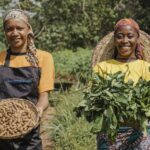Regenerative Agriculture (RA) has been taking over the sustainable development space in recent years, with policymakers, corporates, and NGOs alike extensively using the terms. So has impact measurement. It is defined as a holistic agriculture approach that restores ecosystems’ health and maintains them in a resilient state. It holds many promises, not only positive social and environmental outcomes but also a compelling business case for farmers.
While becoming popular in OECD countries, with large-scale farmers having access to the necessary knowledge, infrastructure, and services, it appears much more difficult to replicate these approaches and techniques in the context of smallholder farmers in emerging economies.
As adopting RA practices present a lot of challenges for smallholders, we will explore how data collection and impact measurement can support smallholder farmers in their transition to regenerative agriculture.
Challenges to Transitioning to RA for Smallholders
UPFRONT FINANCIAL INVESTMENT
From past experiences, it appears that shifting to RA production system is often accompanied by a period of decreased yields due to the change in practices. Additionally, large upfront costs are also required from smallholders to prepare their farm and have access to appropriate techniques and tools. However, farmers in southern countries often do not have the means and resources to afford those initial investments and to cope with productivity losses.
ACCESS TO TECHNICAL KNOW-HOW & TAILORED ADVISORY
Transitioning to RA requires specific technical know-how which most smallholders do not have access to in low to middle income countries. Furthermore, while RA provides overall technical frameworks and approaches, transitioning to RA requires context-specific interventions driven by knowledge on farm’s soil typology and health, current practices, and agronomic system, needs of farmers…
SHIFTING FARMING APPROACH
RA is defined as a holistic farming approach, and thus considers the farm as a system integrating a variety of crops and managed by coexisting practices. It thus requires farmers to change their perspective from crop-specific and focusing on yields to a holistic system interacting with surrounding ecosystems and characterized by a diversity of crops.
LACK OF SOUND SMALLHOLDER DATA FOR EFFECTIVE SUPPORT
While RA appears promising, it seems difficult for smallholders in developing countries to replicate those approaches without support. To that end, public authorities, development agencies, NGOs, and corporates have developed programs to support smallholders in their transition. However, the absence of data profiling makes it difficult to engage with farmers.
Indeed, to engage with smallholders, some critical questions need to be addressed to tailor effective programs:
- Who are the farmers at the first mile of the supply chain?
- How should we define a smallholder farmer?
- What is the profile of farmers producing this commodity?
- Which level of fragmentation of the supply chain?
- What are the challenges faced by these smallholders?
Addressing these questions allows to design effective and context-specific programs providing farmers with the necessary technical training, advisory, and access to services that will support them in transitioning to RA.
In this respect, leveraging data collection and impact measurement approaches at smallholder level can smooth farmers’ transition to regenerative agriculture.
Mainstreaming Smallholder-level Impact Measurement for Effective Transition to Regenerative Agriculture
FARMERS & FARMS DATA PROFILING FOR EFFECTIVE REGENERATIVE AGRICULTURE TRANSITION
Transitioning to RA requires detailed knowledge on the profiles of farmers and their farms. Indeed, defining a clear baseline of household income, current practices, farmers’ needs, help tailor context-specific approach allowing to minimize productivity losses when shifting cultivation principles. However, as described above, there is a clear lack of data facilitating good understanding of smallholder in their diversity. As such, leveraging digital tools can help collecting data at scale compared to traditional fastidious methods.
INCREASED EFFICIENCY WITH DATA-BASED DECISION
Field-level data can help provide smallholders with tailored prescriptive advisory services. With data derived on the specific context of their agronomic system, farmers can be provided with better decision-making, improving the efficiency of their farm in terms of water management or crop productivity for example.
CONNECTING SMALLHOLDERS TO MARKETS
For a compelling business case for transitioning to RA for smallholders, access to market is key. Aggregating production data at smallholder level ease the physical aggregation of supply among smallholder farmers and thus to reach volume threshold imposed by buyers. Working within coalitions of small producers, collectors, and transformers makes it possible to predict volumes, inform buyers on deliveries, as well as to ease certification and provide full traceability.
IMPROVING SMALLHOLDERS’ FINANCIAL INCLUSION
As mentioned above, a major roadblock to smallholders’ transition to RA is the investment required to initiate and bear the economic impacts of the transition. While smallholder farmers generally cannot rely on financial institutions as their profile is deemed risky, digital data collection on farm & production data offers a solution. Indeed, aggregation of production and financial data on farms’ business models and P&Ls can help improve farmers’ credit profile. This can in turn be used to solicit a loan from microfinance institutions for example.
EFFECTIVE PROGRAM MANAGEMENT SUPPORTED BY IMPACT MEASUREMENT
Data collected during baseline process used comparatively with field data collected regularly from smallholders help program developers in appropriately engaging with smallholders. Indeed, it allows for a finer understanding of smallholders’ livelihoods determinants and thus design programs targeting impactful intervention areas. In addition, it informs developers of any course-correction action to be implemented.
Same can be said of smallholders’ management of their farms. Using digital to provide smallholders with an access to a visualization of their performance can help them assess implemented practices and improve their effectiveness.
Impact measurement mainstreaming and digital tools can be effective in supporting smallholders’ transition to regenerative agriculture. However, field implementation of data collection processes is proven to be more complex.
Ksapa’s Take on Field Impact Measurement
KSAPA’S SUTTI INITIATIVE FOR REGENERATIVE AGRICULTURE
As part of its impact investing business, Ksapa has developed responsible sourcing programs for corporates aiming at reconnecting with the first mile of the value chain: smallholders. As an example, Ksapa developed a 1,000 natural rubber smallholder program in collaboration with Michelin Group and a german automaker in Indonesia.
Ksapa developed its flagship SUTTI initiative – Scale Up Training Traceability Impact – to deliver scalable capacity-building programs across fragmented value chains. Our in-house digital suite indeed maximizes access to training via an e-learning tool and tracks program impact against social, environmental, and economic performance targets. This ultimately helps industrial groups better understand their procurement map and gives smallholders control over their farm. It also powers information-sharing and data collection via a low-tech solution, making it altogether adaptable to most contexts and users, including vulnerable populations.

SUTTI’s 360° approach, leveraging regenerative agriculture systems, also caters to smallholders’ needs. As such, farm diversification is an integral part of the strategy to help smallholders transition.
Hybrid learning allows for close relationship and tailored advisory while reaching scale with digital content.
FIELD CHALLENGES FOR IMPACT MEASUREMENT
However, roadblocks still remain when engaging rural populations with digital tools & processes:
- High disparity in digital literacy among farmers (elder vs youth)
- An inequal access to infrastructure & equipment between rural communities (phones, data, network coverage…)
- Necessary incentivization of farmers in regularly providing farm performance data
- Sharing and aligning with farmers on data collection & impact measurement rationale
- Ensuring project developers & farmers are aligned on data privacy rights
- Lack of financial management knowledge to understand KPIs collected and computation methodologies
Conclusion
Smallholders’ transition to regenerative agriculture needs to be supported by capacity-building programs managed using digitized impact measurement. Effective engagement of smallholder farmers as well as tailored support in decision-making, infrastructure, and services depend on it.
However, implementing a digitized data collection process with rural populations requires calibration. Each field challenge calls for context-specific interventions across programs.
Adrien is a SUTTI Program Officer. He’s responsible for the development, operational implementation, and monitoring of SUTTI programs. He participates in designing financial structuring schemes leveraging SUTTI’s impacts.
He has previous experiences in various industries, within public, private, and non-profit organizations. Before joining, he was involved in microfinance and social entrepreneurship initiatives in Cambodia and the Philippines, after working for Danone and RATP.
He holds a Master’s in Finance from Paris-Dauphine University, as well as a Master in Management from ESSEC Business School.
He speaks French, English, and Spanish.






